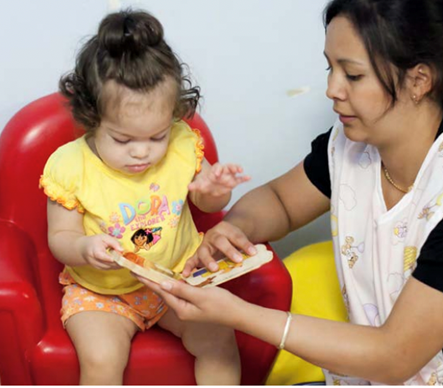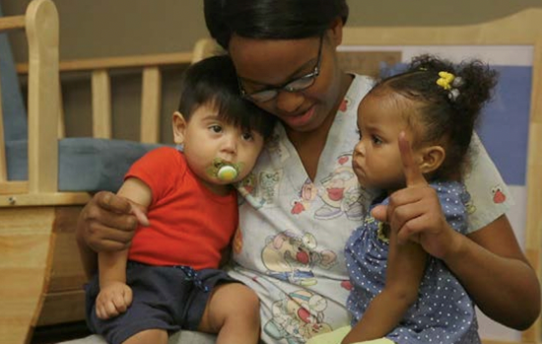22.1: Introduction
- Page ID
- 142187
Introduction to Primary Care
High quality care and education for infants and toddlers begins with relationship-based care (Mangione, 2006). Primary caregiving is a relationship-based practice and is the practice of assigning each child (and family) to a caregiver who will serve as the primary source of information and care for the child. Primary caregiving enables caregivers to develop deep relationships with children and their families and offers opportunities to provide individualized care and interactions during daily routines and experiences. This focused care by a familiar adult can provide infants and toddlers with a sense of predictability and security that comes with knowing each child’s unique needs and preferences. [1]

Primary caregiving does not mean that caregivers care only for their small group of children to the exclusion of the other children in the group. Rather, it means that each caregiver, to the extent possible and practical in a group care situation, cares for and responds to children’s routine care needs (e.g., eating, toileting, diapering, sleeping) who are assigned to them. However, caregivers also work as a team and rely on each other as backup when they are not able to work directly with their particular children. For example, if a caregiver is busy changing one child’s diaper, the other caregivers in the room still continue to provide care for the other children until their primary caregiver returns. Another reason why primary caregiving should be conceptualized as a team effort rather than exclusive care, is when a primary caregiver is not able to work (e.g., sickness, vacation, etc.,). It is imperative for all the caregivers to have respectful relationships and establish trust with all of the children, even those children outside of their primary care assignment. Of equal importance, parents and other family members know who has primary responsibility for their child; this can strengthen the parent-caregiver relationship and communication between home and the childcare program. [3]
While primary caregiving is a common practice in the U.S., it is not a commonly implemented practice worldwide, even in highly-developed countries. In Singapore, for example, primary caregiving is not frequently practiced with infants and toddlers (Ebbeck et al., 2015). However, in a different study with parents of children under three years of age in Singapore, most parents expressed wanting to have their child cared for by the same caregiver and parents in programs that did implement primary caregiving reported high levels of satisfaction with the practice (Ebbeck, Yim, Ho & Sharma, 2022).
Despite the strong recognition of the importance of primary caregiving from organizations such as Zero to Three, the Program for Infant and Toddler Care (PITC) and the National Association for the Education of Young Children (NAEYC), there is very little empirical evidence directly investigating primary caregiving as a practice (Lee, Shin & Recchia, 2016). The research that is used to justify the importance of primary caregiving comes mainly from empirical explorations into the development of attachment. Since primary caregiving is a practice that encourages the development of a secure attachment between caregivers and children, it is often assumed that primary caregiving would also support the positive developmental outcomes associated with secure attachment (Bernhardt, 2000; Lally & Mangione, 2017).

[1] “Individualizing care for infants and toddlers - part 1” from Head Start ECLKC is in the public domain.
[2] Image from “Individualizing care for infants and toddlers - part 1” from Head Start ECLKC is in the public domain.
[3] “Individualizing care for infants and toddlers - part 1” from Head Start ECLKC is in the public domain.

